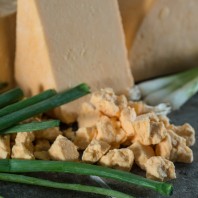|
 |
 |
Farmhouse Cheshire |

Country: England
Cheese Texture/Type: Firm
Cheese Milk Type: Cow
Cheese Age: 3 Months
|
|
|
Your first selection this month is an artisanal Farmhouse Cheshire hailing from the county of Cheshire. Cheshire cheese is one of England's oldest cheese varieties; it’s thought to predate Roman times. When England was a province of Rome, the city of Cheshire was widely known for its fine cheeses. So remarkable were these cheeses that the Romans built a wall around the town to protect them. A bit drastic perhaps, but building a wall around your refrigerator might be something to consider if family members start storming your supply! Today, authentic Farmhouse Cheshire is difficult to find. Only a few dairies in Britain produce it and the bulk of it is bought up by the locals, so very little ends up being exported. The rare variety you’re receiving this month is aged from three to nine months, which gives it a rich, full-bodied, fresh flavor. Note its firm, silky texture. It may be slightly crumbly. Unlike Farmhouse Cheshire, all other Cheshire cheeses are young—typically they’re aged about eight weeks.
A Favorite of William the Conqueror
Cheshire cheese has a rich history. It was renowned during the medieval period, and Norman women who made Cheshire cheese were mentioned in the Doomsday Book, 1086 A.D. It is said to have been a favorite of William the Conqueror. Five hundred years after William’s death, the sixteenth century historian John Speed declared that Cheshire was the very best cheese in all of Europe. Cheshire is a cheese with some serious history—it has maintained its prominence for over a millennium! The county of Cheshire was originally famous for its sheep's milk cheeses, but Cheshire cheese has always been made from cow's milk, as are most of the cheeses now made in northern England. This area of the country is fortunate to be naturally irrigated by the River Dee, and the minerals it has deposited for centuries are critical to the dynamics leading to Cheshire's distinct flavor. Cheshire cheese has a slightly salty flavor, owing to the characteristics of the area's soil, which has a high concentration of underlying bedrock salt. The salt and minerals make their way into the cheese via the grass eaten by the cherished cows which graze the region. In order to meet the standards that define Cheshire cheese, a cheese must be made solely from milk derived from pastures in the county of Cheshire, and it must be created there as well. Use of a very specific cheesemaking process is also required, and the aging of this cheese is also carefully regulated. Cheshire cheese comes in three varieties: White (which is actually pale yellow), Red (cantaloupe or apricot colored), and Blue. The Red Cheshire is organically dyed with annatto, a flavorless coloring agent derived from the pulp of Annatto trees grown in the tropics. It actually tastes the same as the White variety; but, since most English cheeses are similarly colored, it really steals the show at the cheese shop! Blue Cheshire boasts a beautiful golden interior veined with blue, and is just as rich as Stilton, but milder in flavor.
|
| Tasting Notes: |
|
Describing the flavor of this cheese is a bit challenging. Its uniqueness makes it easier to contrast its flavors with other similar varieties; it is neither nutty like Comte, nor fruity like Mahon, nor sharp like Cheddar. It is slightly salty with a mild, rustic, tangy flavor. A popular table cheese, the Cheshire we've selected for you has a modest 48% fat content. Fruits like grapes and pear and apple slices make excellent pairings. Cheshire is a great addition to any cheese tray. As with all cheeses, be sure to let it come to room temperature in order to enjoy it fully!
| |
|
06/04/2015
|
|